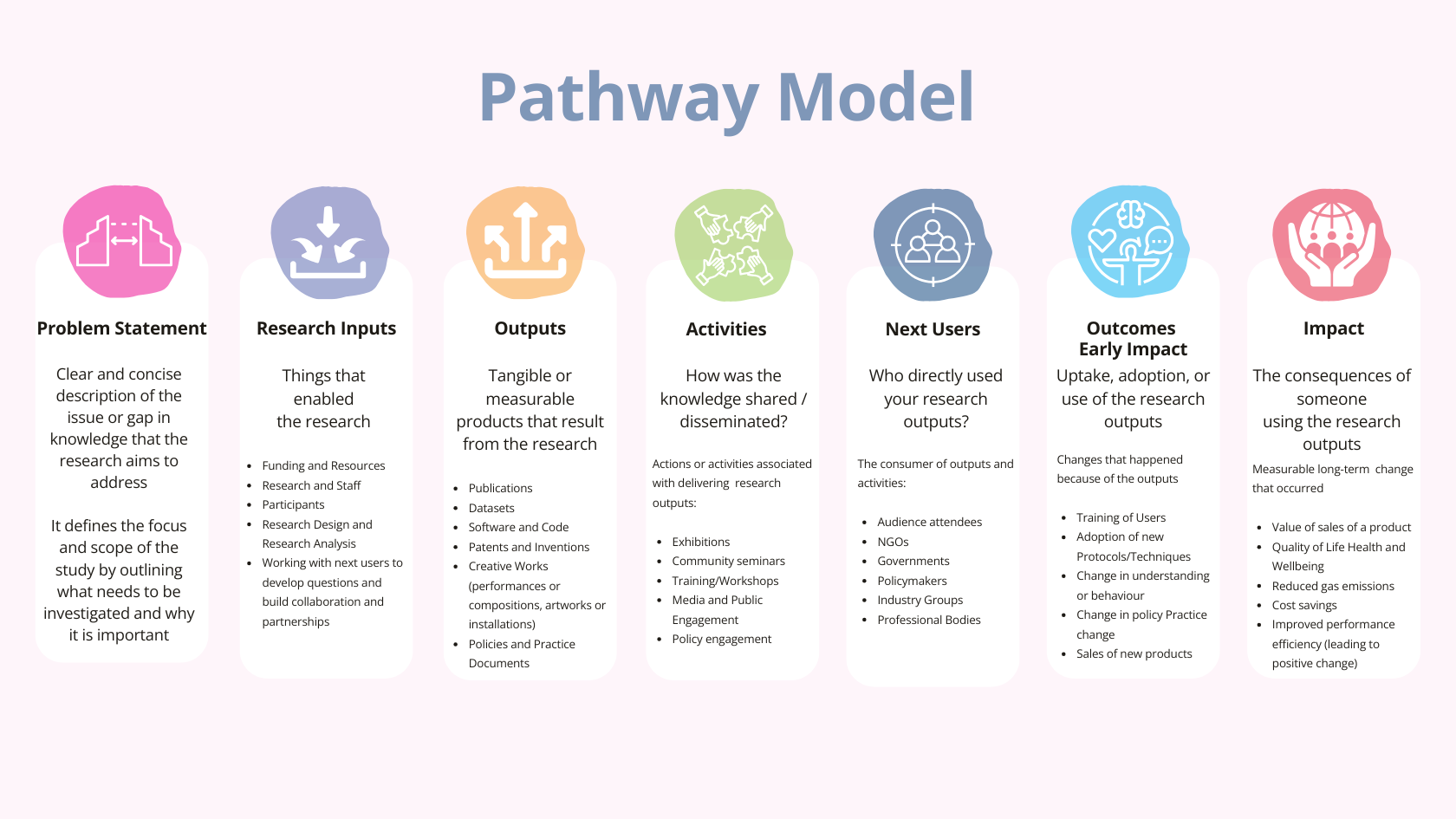Why should we plan for impact?
Planning for impact is essential to ensure research achieves its intended benefits and contributes effectively to society. It helps researchers clearly identify potential beneficiaries and engage with stakeholders to maximise the research's impact. Appropriate planning can transform impact from a possibility into an inevitability, making the research more efficient and increasing the chances of funding success.
Key reasons for impact planning include:
- Maximising research benefits by tailoring engagement strategies
- Enhancing funding success through well-articulated impact plans
- Efficient use of resources by organising activities towards meaningful impacts
- Providing a framework for tracking progress and reporting outcomes
- Aligning research with stakeholder needs to increase uptake and use
Researchers often need to "think outside the box" and involve users/stakeholders when planning, rather than assuming their wants. This approach helps in market research and increases the likelihood of research uptake.
Visualising your pathway to impact
Visualising the pathway to impact involves creating a clear and detailed plan of how the research will achieve its goals. This process includes:
- Impact pathway mapping: Visualise the steps from research activities to desired impacts, identifying key milestones, outputs, and outcomes.
- Using logic models/theory of change approach: Employ logic models or theory of change frameworks to illustrate how research activities lead to intermediate outcomes and long-term impacts.
- Flexibility and adaptation: Design pathways that can adapt to new opportunities or challenges during the research process.
- Considering timelines: Map out both short-term outcomes and longer-term impacts.
- Showing logical progression: Demonstrate linkages between knowledge shared and resulting changes.
- Including indicators: Incorporate measurable indicators to track progress along the pathway.
A well-articulated pathway can significantly enhance the chances of securing funding and achieving the intended impact.
Creating an impact plan
An impact plan is a structured document that organises the steps and activities required to achieve research impact. Key elements in creating an effective impact plan include:
- Setting objectives: Clearly define impact objectives and align them with research goals.
- Identifying activities: List strategies and actions to achieve the impact objectives.
- Allocating resources: Determine and allocate the necessary time, budget, and personnel for each activity.
- Monitoring and evaluation: Develop indicators to track progress and evaluate the success of impact activities.
- Stakeholder engagement: Outline how stakeholders will be involved and how their feedback will be incorporated.
- Specific deliverables and milestones: Include concrete targets and timelines.
- Translation activities: Plan for dissemination beyond academic publications.
- Flexibility: Build in processes to assess what works and adapt as needed.
- Contextual consideration: Tailor plans to your specific research context.

Pathway Model Template and Example
Click here to download the blank template to do your own mapping and find an example.
Problem Statement
Defining your impact goal
This involves identifying the most important impact you wish to achieve. Process includes:
Identifying key benefits: Determine who will benefit from the research and 8in what ways, considerer societal, economic, environmental, or cultural impacts.
Setting clear objectives: Articulate desired outcomes using SMART criteria.
Aligning with stakeholder needs: Ensure impact goals align with the priorities of key stakeholders, including funders, policy makers, community groups, and industry partners.
Considering Motivations: Reflect on what motivates you as a researcher, and align these with funders' aims and objectives.
Focusing on "who", "how" and "what": Consider the pathway of research as well as the ultimate impact.

By clearly defining your impact goal, you can better recognise opportunities and actions that will help you reach this objective.
Research Inputs
Things that enabled the research:
- Funding and Resources
- Research and Staff
- Participants
- Research Design and Research Analysis
- Working with next users to develop questions and build collaboration and partnerships

Research Outputs
Tangible or measurable products that result from the research:
- Publications
- Datasets
- Software and Code
- Patents and Inventions
- Creative Works (performance or compositions, artworks or installations)
- Policies and Practice Documents

Engagement Activities and Next Users
Stakeholder Analysis
Stakeholder analysis is crucial for understanding who might be affected by or interested in your research.
Developing Engagement Plans
Engagement plans should be developed collaboratively with stakeholders to ensure their needs and priorities are genuinely met.
The Engagement Spectrum
The engagement spectrum represents various levels of stakeholder involvement in research projects.
Stakeholder Engagement
Effective stakeholder engagement is crucial for successful research projects.
Engagement Across a Research Cycle
Engagement should be planned and executed throughout the entire research cycle
Communication for Engagement
See what's involved in effective communication with stakeholders
Public Engagement Strategies
Public engagement involves offering opportunities for the public to interact with the research at various stages
Choosing Communication Channels
Selecting appropriate communication channels is crucial for effective engagement
Navigating Engagement Channels
See the requirements of effectively navigating engagement channels
Outcomes / Early Impact
Uptake, adoption, or use of the research outputs
Changes that happened because of the outputs:
- Training of users
- Adoption of new protocols / techniques
- Change in understanding or behaviour
- Change in Policy
- Sales of new products

Impact
The consequences of someone using the research outputs
Measurable long-term change that occurred:
- Value of sales of a product
- Quality of life health and wellbeing
- Reduced gas emissions
- Cost savings
- Improved performance efficiency (leading to positive change)


References
Find a full list of references and further reading
